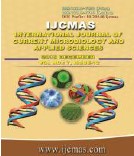


 National Academy of Agricultural Sciences (NAAS)
National Academy of Agricultural Sciences (NAAS)

|
PRINT ISSN : 2319-7692
Online ISSN : 2319-7706 Issues : 12 per year Publisher : Excellent Publishers Email : editorijcmas@gmail.com / submit@ijcmas.com Editor-in-chief: Dr.M.Prakash Index Copernicus ICV 2018: 95.39 NAAS RATING 2020: 5.38 |
Wheat (Triticum estivum L.) is the major and important winter cereal food crop grown in India during Rabi season. The crop suffer from a number of devastating disease by fungi, bacteria, virus, phytoplasmas, nematodes and many other factors which educe yield and quality. The major fungal disease of wheat, spot blotch caused by Bipolaris sorokiniana is the most devastating disease in India and several other countries. The diseases affect all areal part of the plant.. Many new fungicides and biocides have been under taken to evaluate with poison food method. Out of nine fugicides in different concentrations of seven fungicides and two biocides (Neemexel and T. viride) have been revealed that the dose no. 4th (D4) have given best result to reducing mycelial growth of Bipolaris sorokiniana comparison to others. It has also found that the growth of fungus was fast up to first four days and after that it is gradually reduced. In some concentrations like, 0.12%, 0.25% growth of mycelia was stringent after fifth days of inoculation. The maximum inhibitory effect with 73.33% reduction was recorded at 0.25 % concentration of Nativo 75 WG fungicides which was statistically at per with 0.12% concentration. It was followed by 0.06% concentration with 68.88% reduction was recorded with Raxil 060 FS.
 |
 |
 |
 |
 |